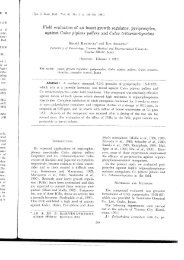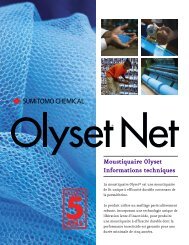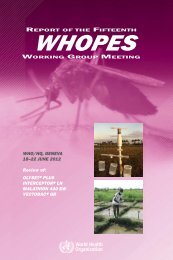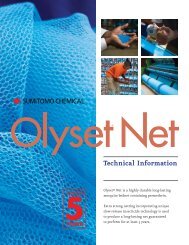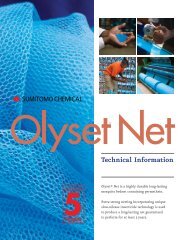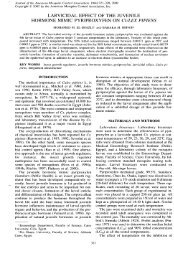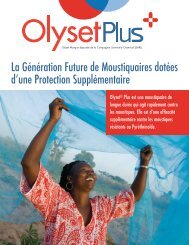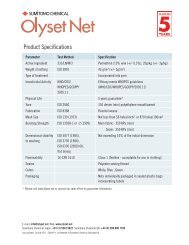ayout 1 - Olyset Net
ayout 1 - Olyset Net
ayout 1 - Olyset Net
You also want an ePaper? Increase the reach of your titles
YUMPU automatically turns print PDFs into web optimized ePapers that Google loves.
Technical Information<strong>Olyset</strong>® net is a unique long-lasting mosquitobednet containing permethrin.The product uses extra strong nettingincorporating unique slow-release insecticidetechnology to produce a long-lasting net forguaranteed insecticidal performance forat least five years.
Introduction and BackgroundBackgroundMosquito-borne disease transmissionposes one of the greatest threats tothe tropical world, and with theadvent of global warming is anincreasing concern for temperatecountries. Of all the mosquito-bornediseases, malaria remains one of thegreatest problems in tropical countries,adversely affecting population healthand economic development. Malariakills 1-2 million people every year,with 90% of the deaths occurringin sub-Saharan Africa. The mostvulnerable sections of the populationare pregnant women and children.Malaria is both preventable andtreatable. Given the cost and logisticsof rapid diagnosis and treatment inmany African countries, the old saying‘Prevention Is Better Than Cure’remains true. If the infected mosquitocan be prevented from biting people,the disease transmission cycle is broken.This protection can be effected inmany ways, from indoor residualspraying (IRS) of insecticides to theuse of aerosols and mosquito coils.Mosquito nets are not new – theyhave been around for at least 100years. What was new was theaddition of insecticide to those nets:the development of insecticide-treatedbednets provided a means to protectpeople throughout the night andat the same time kill the mosquitoes.The advent of pyrethroid insecticidesmade a very effective addition,offering rapid action and good killof insects with low toxicity to people.The first insecticide formulationsmarketed for treatment of netsrequired manual dilution and dippingof nets. These treatments washout after three washes, and thereforeonly last from six months to one yearbefore losing efficacy. The logistics ofregular re-dipping of nets, especiallyin remote villages was so difficultthat it was rarely totally successful.It soon became apparent that along-lasting factory treatment wasrequired so that no re-treatment ofthe nets would be needed duringtheir subsequent life in the field.Industry rose to the challenge andcreated new long-lasting insecticidalnets (LLINs, also referred to as LNs),which changed the face of malariacontrol programmes. <strong>Net</strong>s can nowbe distributed with no need forteams to return regularly to re-treatnets. Ordinary LLINs survive severalSumitomo Chemicalscientists combinedtheir expertise ininsecticides andplastics technologiesto develop <strong>Olyset</strong> <strong>Net</strong>years in the field without furthermaintenance, and survive at least 20washes without losing insecticidalperformance.To develop LLINs, most manufacturerstook existing 75 denier polyesternets and created new formulationsof insecticides with resinsadded to bind the insecticide to theContentsIntroduction and Background ......................1Product Concept.............................................2Manufacturing Process ................................2Controlled Release Technology ...................4How Does <strong>Olyset</strong> Work? ...............................4Cost Efficacy ...................................................5Biological Testing ...........................................6WHOPES ..........................................................8Usage and Care of <strong>Olyset</strong> <strong>Net</strong>......................8Safety................................................................8Technical Specifications........................8 & 9surface of the net fibre. SumitomoChemical, with 2000 employees dedicatedto research and development, isa world leader in the discovery ofinnovative solutions for control ofinsect pests affecting the health andwelfare of mankind. Their focusedapproach led to the development of<strong>Olyset</strong>—a polyethylene net with theinsecticide incorporated within thefibres. <strong>Olyset</strong> nets are more complicatedto manufacture than ordinaryLLINs, but have many advantagesover conventional approaches.<strong>Olyset</strong> <strong>Net</strong> Key Features• Always ready to use – Neverneeds re-treatment• Most durable net on the market• Insecticidal performanceguaranteed for at least five years• High durability to washing• Very strong, doesn’t tear easily• Wide mesh for improved airflowand comfort when sleeping1
Manufacturing ProcessProduct Concept12 3<strong>Olyset</strong>’s design difference<strong>Olyset</strong> nets have three key designdifferences—insecticide, material,and mesh size—that distinguishthem from ordinary LLINs and confergreater efficacy, strength andcomfort. These reflect SumitomoChemical’s unique approach in theincorporation of insecticide, materialselection and mesh size.4586 7 9<strong>Olyset</strong> nets start life as a ‘master batch’ of granules containing permethrin and thepolyethylene-based formulation technology. (1) This technology, by which the insecticideis included in the polyethylene, is the secret that makes <strong>Olyset</strong> unique. Proprietaryingredients are included that control the rate at which permethrin is released, to ensurereplenishment and maintenance of a biologically effective surface dose for at least fiveyears. The master batch is sent to <strong>Olyset</strong> factories in Africa and Asia, where it is meltedand extruded into fibres (2, 3, 4, 5). The fibres are subsequently knitted into rolls of net(6). These are then cut and sewn into the final product (7, 8). Finally, they are checkedfor quality assurance (9).Insecticide<strong>Olyset</strong> nets use the insecticide permethrin,which is a second-generationpyrethroid.The choice of permethrin wasmade because it has a high margin ofsafety, exhibiting low mammaliantoxicity with high activity on insects.Permethrin has decades of successfuluse in public health applications,including medically-approved humanskin applications such as head licelotions and shampoos.<strong>Olyset</strong> differs from other LLINson the market, in which insecticideis ‘glued’ to the outer surface of thenet fibre; consequently the availableinsecticide reduces with handling,wear, and washing until there is noneleft. Sumitomo Chemical scientiststook a totally different approach totreatment of the net, deciding toincorporate the insecticide withinthe fibre and to develop technologyallowing its migration to the surfaceof the fibre over an extended time.Liquid permethrin, along with specialrelease-control agents, is incorporatedinside the raw polyethylene matrix.This is then extruded into monofilamentfibres from which the net is2
subsequently manufactured. The activeingredient is slowly released onto thesurface of the fibre over time andthe surface concentration reachesequilibrium, so when insecticide isremoved from the fibre throughwashing, the surface concentration isreplenished from the reservoir within.The surface concentration is maintainedat a level sufficient for biologicalactivity against mosquitoes.MaterialBednets have a tough life underconditions of everyday use in ruralvillages, and can easily be damagedor torn. Sumitomo Chemical decidedto make a very tough net whichcould better survive these challengingconditions. Therefore, it chosepolyethylene as its fibre material anda denier of >150, which is double theusual 75 denier polyester LLINs onthe market. It is these factors whichallow <strong>Olyset</strong> nets to last longer thanpolyester LLINs.If <strong>Olyset</strong> has a wide mesh,do mosquitoes pass throughthe holes?Some people avoid sleeping underordinary bednets because theyperceive them to be hot anduncomfortable. The wider mesh of<strong>Olyset</strong> is a deliberate design featureto improve the airflow and hencecomfort, thereby encouragingbednet use.Even though <strong>Olyset</strong> has a largerthan average mesh size to improveventilation, field data have shownthat penetration of the net bymosquitoes is very rare. Firstly,<strong>Olyset</strong> contains the insecticidepermethrin, which is highlyrepellent to insects. As mosquitoesreach the net, they detect the permethrinand are repelled (see page 4 formodes of action). Secondly, it isimpossible for mosquitoes to passthrough the mesh without touchingFig. 1Size of <strong>Olyset</strong> net vsAnopheles mosquitoesthe net (Fig. 1). In doing so, theyreceive a lethal dose of insecticidewhich prevents biting and leads torapid knockdown and kill.3
Controlled Release Technology<strong>Net</strong> ageing 1-5 years: <strong>Olyset</strong> vs. Conventional LLIN<strong>Olyset</strong> <strong>Net</strong>permethrin insecticideYear 1 Year 2 Year 3 Year 4 Year 5Conventional LNInsecticide particles“glued” to net surfaceYear 1 Year 2 Year 3Above: For <strong>Olyset</strong> net, permethrin migrates tothe surface of the net fibre over a five-year period,maintaining a constant surface concentration.This enables Sumitomo Chemical to guarantee<strong>Olyset</strong>’s insecticidal performance for five years.Left: For conventional LLINs, surfaceconcentration of insecticide declines overa three-year period.How Does <strong>Olyset</strong> Work?Bite InhibitionInsecticide causes themosquitoes not to bite<strong>Olyset</strong> has a four-fold insecticidalaction against mosquitoes—biteinhibition, repellency, knockdownand mortality—all of whichcontribute to protect the peoplesleeping under the <strong>Olyset</strong> net.Additionally, the net provides asubstantial physicial barrier.Repellency/ExpellencyContact with theinsecticide causesmosquitoes to leavewithout taking ablood mealPhysical BarrierKnockdownand MortalityInsecticide causesknockdown or deathof mosquitoes4
Cost EfficacyElectron Microscopy<strong>Olyset</strong> <strong>Net</strong>The comparative cost of <strong>Olyset</strong> nets with IRS and even other polyester bednets is avery important consideration. When calculating costs, the price of the insecticideis only part of the picture. The cost of application, equipment required, frequencyof re-application, and distribution must be included to understand the whole cost.With LLINs, the cost per year is based on the number of people sleeping under thenet and the life of the net in years. As <strong>Olyset</strong> nets last at least five years, the costsare very favourable to <strong>Olyset</strong> over time.Intervention/Insecticide Programme Cost per person/yearIRS/Carbamate $4.80IRS/DDT $2.77IRS/Pyrethroid $2.16LLIN/Polyester $1.00LLIN/<strong>Olyset</strong> $0.68Reference: WHO Global Malaria Programme Strategic Technical Advisory Group, May 2006Thin liquid film of Permethrin ispresent on fibre surface and iscontinually replenished by theinternal reservoir.Conventional LLINUsing the data of C.Lengeler published in the Cochrane Review 2007, the valuein additional lives saved by <strong>Olyset</strong> nets can be calculated as well. Lengeler statesthat 5.5 child deaths are prevented for every 1000 children who are protected bya net for 1 year. Because an <strong>Olyset</strong> net lasts for at least five years compared to amaximum of three years for a polyester net, and assuming two children sleepunder each net, an additional 22 lives would be saved per 1000 <strong>Olyset</strong> nets used.Insecticide particles “glued” to netsurface.Above: The photographs, which aremagnified many thousands of times, showthe difference between <strong>Olyset</strong> and ordinaryLLINs where insecticide is simply “glued”onto the net fibre.5
Biological TestingWash Proof Tests on <strong>Olyset</strong> <strong>Net</strong>s<strong>Olyset</strong> nets have passed the >20 washestest required by the World HealthOrganization to be designated anLLIN (Fig. 2).Fig. 210080604020Laboratory evalution of <strong>Olyset</strong> nets.24 hour mortality rates following W.H.O ConeBioassay – 3 minute exposure to net samplesafter numerous washes01 2 3 4 5 6 7 8 9 10 11 12 13 14 15 16 17 18 19 20Number of washesA. aegypti Comparative Efficacy and Persistency of Permethrin in <strong>Olyset</strong> <strong>Net</strong>Jeyalakshmi, J. & Rhanmugasundaram, R International InstituteA. stephensi of Biotechnology and Toxicology, TamilNadu, IndiaBiological Tests on <strong>Olyset</strong> <strong>Net</strong>s<strong>Olyset</strong> nets are guaranteed for fiveyears, and field tests have shown thatthis is a conservative estimate oftheir effective life. In Tanzania,field trials showed that when 10 netsfrom the field were tested afterseven years of normal use they stillcontained significant levels ofpermethrin and in contact tests hada mean knockdown of mosquitoesof 92% (Fig. 3).6Fig. 3Knockdown 60 minutes after3 minute exposureKnockdown evaluation of Anopheles sp.on 7 year old <strong>Olyset</strong> nets–Tanzania10090807060504030201001 2 3 4 5 6 7 8 9 10SamplesRef: Tami et al., Malaria Journal 2004, 3:19<strong>Olyset</strong> Impact on Vectors<strong>Olyset</strong> nets reduce the numbers ofmosquitoes both indoors and outdoors.A field trial in a Cambodianvillage compared their impact onanopheline mosquitoes with a controlvillage provided with standarduntreated nets. The results presentedbelow show the % reductions fromJune to December in comparison tothe control village data (Fig. 4).Fig. 4% Reduction compared with untreatednet villageField trial of <strong>Olyset</strong> nets — CambodiaReduction in mosquito catches in <strong>Olyset</strong> net treatedvillage June - Dec50454035302520151050IndoorOutdoorAn. dirus - <strong>Olyset</strong>An. minimus - <strong>Olyset</strong> Ref; Chheang & Sandy, National Malaria Centre, Cambodia. 1994Human bait catches of mosquitoesover five months in two villages thathad <strong>Olyset</strong> nets showed dramaticreductions in the numbers ofmosquitoes caught (Fig. 5).Fig. 5% ReductionSenegalHuman bait catches of mosquitoes in two villages.% reductions after introduction of <strong>Olyset</strong> nets1009080706050403020100July Aug Sept Oct NovWassadouBadi Ref: Faye, O. Universitte Cheikh Anta Diop, Dakar, Senegal. 1996<strong>Olyset</strong> Impact on DiseaseIn the same trial in Cambodia asFig. 6, there was a follow up on theimpact on malaria Slide PositivityRate (SPR), incidence per 1000population and mortality comparingtwo similar six-month periods.There were enormous reductions inall three measures of malaria, asillustrated below (Fig. 6).Fig. 6CambodiaComparison of reductions of malaria incidence andmortality in study area pre and post <strong>Olyset</strong>introduction (July-Dec 1993 and July-Dec 1994)140120100806040200Slide positiverate %Incidence per1000Total deathsMortality rateper 1000Pre <strong>Olyset</strong>Post <strong>Olyset</strong>% Reduction Ref; Chheang & Sandy, National Malaria Centre, Cambodia. 1994In Tanzania, a trial was conductedcomparing one year pre-interventionand one year post-intervention using<strong>Olyset</strong> nets in three villages (Fig. 7).Fig. 7% ReductionAPRMPDTanzaniaMalaria parasite rates and densities in children
espectively, whereas in the controlarea there was no significant changein APR and an increase in MPD wasobserved.Trials of <strong>Olyset</strong> <strong>Net</strong>s on MalariaTransmission in IndiaA recent trial in India showed a hugeimpact on the major malaria vectorAn. culicifacies with a reduction of 71%of mosquitoes found indoors comparedto only 35% reduction for untreatednet and no impact without a net(Fig. 8).The other main intervention againstmalaria is indoor residual spraying(IRS). DDT is one of the recommendedmaterials. In this trial conducted inEcuador, <strong>Olyset</strong> was more effectivethan DDT residual spray in preventingmalaria. LLINs and/or IRS maybe prescribed depending upon localcircumstances, including malariaprevalence. Generally, IRS programsare more costly than bednet placementbecause IRS requires each houseto be sprayed every 6-12 months bytrained spray teams, with associatedlogistical costs and challenges (Fig. 10).Fig. 8No. mosquitoesNumber of Anopheles culcifacies mosquitoesresting indoors caught per man hour in villages706050403020100Pre-distributionPost-distribution<strong>Olyset</strong>71% reduction35% reductionUntreated netNo netRef. Sreehari et al., 2007J Vect Borne Dis 44, June 2007, pp. 137-144Fig. 10% ReductionComparative impact on malaria: DDT vs. <strong>Olyset</strong>trials in Ecuador—S. America9080706050403020100% reduction in API% reduction in malaria cases<strong>Olyset</strong> only DDT spray ControlRef: -Field efficacy of <strong>Olyset</strong> net for malariacontrol in 3 villages in EcuadorDr. LT Yepez—Director of SNEM, EcuadorThe resulting impact on people inthese villages is shown in Fig. 9where there was a 96% reduction infeverish patients showing positive formalaria.Fig. 9Blood slides collected from feverish patientswhich were positive for Plasmodium.35% positive for Plasmodium302520151050Pre-TrialPost-Trial<strong>Olyset</strong>96% reductionUntreated netNo netRef. Sreehari et al., 2007J Vect Borne Dis 44, June 2007, pp. 137-1447
World Health OrganizationPesticide Evaluation Scheme(WHOPES)Technical Specifications<strong>Olyset</strong> net was the first LLIN to be submitted to WHOPESfor evaluation, and remains the only LLIN which haspassed all four stages of the evaluation process confirmingefficacy and longevity. <strong>Olyset</strong> is now the only LLINto have earned the full WHO recommendation. The completereport can be read in WHO/CDS/WHOPES/2001.4.(www.who.int/malaria/itmspecifications.html) withadditional information at www.who.int/whopes/quality/permethrin_LN_ July_2006.pdf.Usage and Care of <strong>Olyset</strong> <strong>Net</strong>The net is ready to use. Just unpack and hang over thebed, using the suspension points to attach string or cordand suspend from roof—there is no need to air it for 24hours before use like some other nets. Ensure the nethangs over the bed with sufficient net hanging belowthe mattress or mat to tuck under at night.The net is factory treated with insecticide and neverneeds re-treatment during its anticipated minimumfive-year life.<strong>Olyset</strong> nets may be washed using soap and waterto remove dirt. Gentle washing (with no bleach) isrecommended to avoid damaging the net and removingexcess insecticide. After washing, the net should bedried in the shade before re-hanging over the bed.Once washed, the <strong>Olyset</strong> net regenerates insecticideto the surface of the fibre to replace any lost throughwashing.SafetyThe majority (over 90%) of the permethrin insecticideis contained within the fibre matrix. Sufficientinsecticide is available on the fibre surface at anymoment in time for biological performance. The risksfrom handling or contact are negligible. Permethrin isvirtually non-irritant, so no adverse effects should occurfrom contact or sleeping under the net.Specification (WHO/IS/NI/331/2002)CategoryOdourYarn ColourShapeDimensional Stabilityto washing (ISO 5077)<strong>Net</strong> attachmentActive IngredientActive Ingredient loadingImpregnation TechnologySizes Available (cm)DataOdourlessBlue (Approximate Pantone Ref: 298) or whiteRectangular or Conical±10% of initial dimension (length and width)6 suspension rings (one at each of the fourcorners of the top panel and one equidistantat each of the sides) attached by fabricloops. Conical – single suspension pointPermethrin2% w/wTreated with Permethrin, incorporated intothe polyethylene fibres during themanufacturing processIncorporated in a reservoir inside the netInsecticide locationduring manufactureStorage Stability<strong>Net</strong> material must contain >95% of theoriginal a.i. content after storage at 54°Cfor 2 weeksDuration of Insecticide 5 years (minimum)Efficacy from first useFire Safety Classification Class 1:16CFR 1610(Textiles - acceptable for use in clothing)Yarn>150 denierHigh density polyethylene monofilament fibreMesh Size (holes/inch2) 56 (minimum)Weave TypeRaschelBursting Strength 350 KPa (minimum)ISO 13938-1-1999Ease of tearingHigh tear resistanceFabricationWarp KnittedISO 8388Manufacturing sites China, Vietnam, Tanzania, KenyaRectangular <strong>Net</strong>sDescription Width Length HeightDouble 100 180 150Family 130 180 150Large Family 160 180 150Extra Family 190 180 150Conical <strong>Net</strong>sDescription Circumference Height Roof (diameter)Small 850 220 56Medium 1050 220 56Large 1250 250 65For latest product information refer to website www.SumiVector.com8
Insecticidal Content of <strong>Olyset</strong> <strong>Net</strong>The following information refers to permethrin, the activeingredient in <strong>Olyset</strong> net. Permethrin has been used forpublic health and agricultural insect control for 30 yearsand has an excellent track record. Registered uses ofpermethrin include human skin applications for liceand mite control.Permethrin (Ref VBC/DS/84.51)SYNOPSIS: Permethrin is a composite synthetic pyrethroid;a broad spectrum, non-cumulative pesticide; and, a fastacting neurotoxin with good contact, limited stomach andno fumigant action. It is moderately stable in the environmentand has good residual action on inert surfaces.Permethrin is non systemic in plants; of low mammaliantoxicity, and is readily metabolized with immediate lossof toxicity.Common Name: Permethrin (ISO, BSI, ANSI)Identity:IUPAC: 3-phenoxybenzyl (1RS, 3RS; 1RS, 3SR)-3-(2,2-dichlorovinyl)-2,2-dimethylcyclopropanecarboxylateCA: (3-phenoxyphenyl)methy 3-(2,2-dichloroethenyl)-2,2-dimethylcyclopropanecarboxylateCAS Reg. No.: 52645-53-1Molecular formula: C21H20Cl2O3Molecular weight: 391.3Structural formula:Permethrin ContentDeclared content is 20g/kg (+/-3g/kg), 2%w/w (1.7 – 2.3%limits). Cis/trans isomer ratio: Max. 55% (+/-) cis andMin. 45% (+/-) trans.EcotoxicologyExposure of non-target organisms to permethrin on <strong>Olyset</strong>nets is unlikely when used in accordance with labelinstructions. Permethrin is toxic to fish under laboratoryconditions, so contamination of fish-bearing water shouldbe avoided. <strong>Net</strong>s should be gently washed in containersusing a mild soap as necessary, and not in natural watersources such as streams, rivers, ponds and lakes.Disposal ConsiderationsThe net should be changed when biological performancedeclines. Normally this will occur after approximatelyfive years. Disposal should conform to recommendationsof International organizations and should comply withall federal, state and local regulations.Transport InformationHazard Class: Not classifiedU.N. Number: NonePackagingThe nets are packed in sealed polypropylene bags with fullinstructions for usage. Bags are normally packed in balesfor convenient transport. Typically 40 nets are containedin a bale.StorageStore in a cool, well-ventilated place away from sourcesof ignition and direct sunlight.AnalyticalFull analytical methodology is available in CIPAC/4503/mPermethrin (June 2006).CH 3CH 3ClClC= CHCOOCH 2O9
Find out more at:www.SumiVector.com<strong>Olyset</strong> CustomerService DepartmentHoratio House77-85 Fulham Palace RoadLondon W6 8JAUnited KingdomTel: +44 (0)208.600.7700Email: info@SumiVector.comA to Z Textile Mills LimitedPO Box 945Unga Limited Industrial AreaArushaTanzania+255 27 250 6107/2375 ph+255 27 254 8235 faxinfo@azpfl.com emailPhotographs © M. Hallahan/Sumitomo Chemical<strong>Olyset</strong>® is a Registered Trademarkof Sumitomo Chemical Co., Ltd.© Sumitomo Chemical 2007



